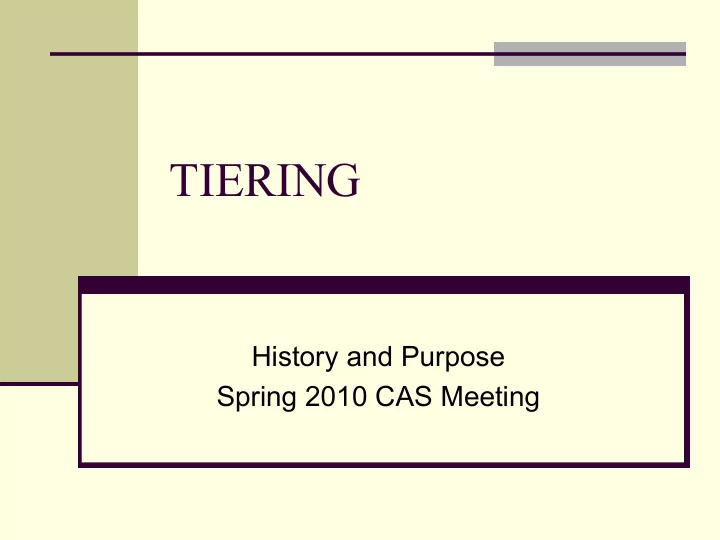

TIERING History and Purpose Spring 2010 CAS Meeting
Agenda n Definition n History n Relationship with Credit n Uses of Tier 2
Tier n Definition: n One of a series of ranks, layers or stratum n Synonyms: n Grade n Category n Level n Grouping 3
History n Agency Insurers – Private Passenger Auto n Bureau derived class plans n Competing with Exclusive Agency Insurers n Needed to further refine pricing n Solution n Fleet of companies, each company is a tier n Each at a separate base rate n E.g. Preferred, Standard, Non-substandard n Virtually same class plan (territories, I/L, etc.) n Set of underwriting rules that tiers new business into one of the companies or a decline 4
Underwriting Guidelines Preferred Standard Non-Standard Company Company Company Driver 23-70 21-70 21-70 Age 21-22 if clean & 17-20 if clean & 16-20 if clean & Driving 5 yrs 3 yrs No minimum Experience Per At Fault 0 At Fault 0 At Fault 1 Policy Not At Fault 2 Not At Fault 2 Not At Fault 2 Driving Minor Convictions 0 Minor Convictions 2 Minor Convictions 3 Record Per At Fault 0 At Fault 0 At Fault 1 Operator Not At Fault 2 Not At Fault 2 Not At Fault 2 Minor Convictions 0 Minor Convictions 1 Minor Convictions 2 Maximum 2 per policy 3 policy 5 per policy Incidents 2 per operator 5
Observations n Overlap with class plan n Underwriting rules – didn ’ t have to be filed in most states n No multivariate analysis n Virtually no reassignment at renewal n Rules adjusted as a function of appetite n Level of success - questionable 6
Catalyst for Change n Credit Score – n New variable introduced in the early to mid- 90 ’ s n Highly predictive n Highly granular (200 to 850) n Phase I n Added to existing underwriting rules 7
Underwriting Guidelines Preferred Standard Below Standard Company Company Company Driver 23-70 21-70 21-70 Age 21-22 if clean & 17-20 if clean & 16-20 if clean & Driving 5 yrs 3 yrs No minimum Experience Per At Fault 0 At Fault 0 At Fault 1 Driving Policy Not At Fault 2 Not At Fault 2 Not At Fault 2 Record Minor Convictions 0 Minor Convictions 2 Minor Convictions 3 Per At Fault 0 At Fault 0 At Fault 1 Operator Not At Fault 2 Not At Fault 2 Not At Fault 2 Minor Convictions 0 Minor Convictions 1 Minor Convictions 2 Maximum 2 per policy 3 per policy 5 per policy Incidents 2 per operator Superior or better Average or better Acceptable or better Credit 8
Old Observations n Overlap with class plan n Underwriting rules – didn ’ t have to be filed in most states n No multivariate analysis n Virtually no reassignment at renewal n Rules adjusted as a function of appetite n Level of success - questionable 9
New Observations n Credit score ranges adjusted with appetite n Predictive power of credit underutilized n A handful of ranges were inadequate n Number of pricing points inadequate n Expensive to file/maintain many companies 10
Modern Solutions n Multivariate Analysis n Balancing of tiering (and potentially class plan) variables n Integration of tiering and class plan variables n Tier within Company n No limit to price points n If possible, maintained as underwriting rules 11
Why use tier? n Relaxed filing requirements for underwriting guidelines n Use of variables that present filing hurdles n Prior carrier variables n Expanded driving record n Personal character variables n Relaxed filing requirements shields from competitors ’ view n Some DOI ’ s require walling off particular variables, namely credit 12
Other uses of Tier 1 n Tier can be used as a complex interaction n Assumption – the strength and slope of some the “ class plan ” variables vary by “ type of risk ” n Segment the universe by “ type of risk ” n Type of risk becomes tier n Interact the class plan variables with type of risk n Result – effectively separate class plans by type of risk or tier 13
Other use of Tier 2 n Overlay new variables on top of an existing class plan n No change to existing plan n Control dislocation to the existing book n Isolate changes to the policy writing system n Methodology n Tiering variables = all new variables n Multivariate analysis n Independent Variable = Loss ratio using current class plan premium n Dependent Variables = new variables n Use aggregate new variable score to establish tier 14
Example n Directly use the factors derived from analysis of the tiering variables n Tier factors is a weighted average of the cumulative score. Variable 1 Variable 2 Cumulative Tier Tier Score Factor Risk A 0.90 0.90 0.81 1 0.85 Risk B 0.95 1.00 0.95 Risk C 1.00 1.00 1.00 2 1.00 Risk D 1.20 1.00 1.20 3 1.27 Risk E 1.10 1.20 1.32 Risk F 1.20 1.20 1.44 4 1.44 15
Other uses of Tier 3 Objective: Use tier to establish new vs. renewal n pricing Tier new business using standard criteria targeting 1) new business losses performance Renewal tiering based on a change model 2) Incorporate variables only available for renewal a) business Eliminate use of variables only relevant to new b) business Reduce reliance on variables that are more powerful c) for new business than renewal Control tier movement at renewal d) 16
Recommend
More recommend